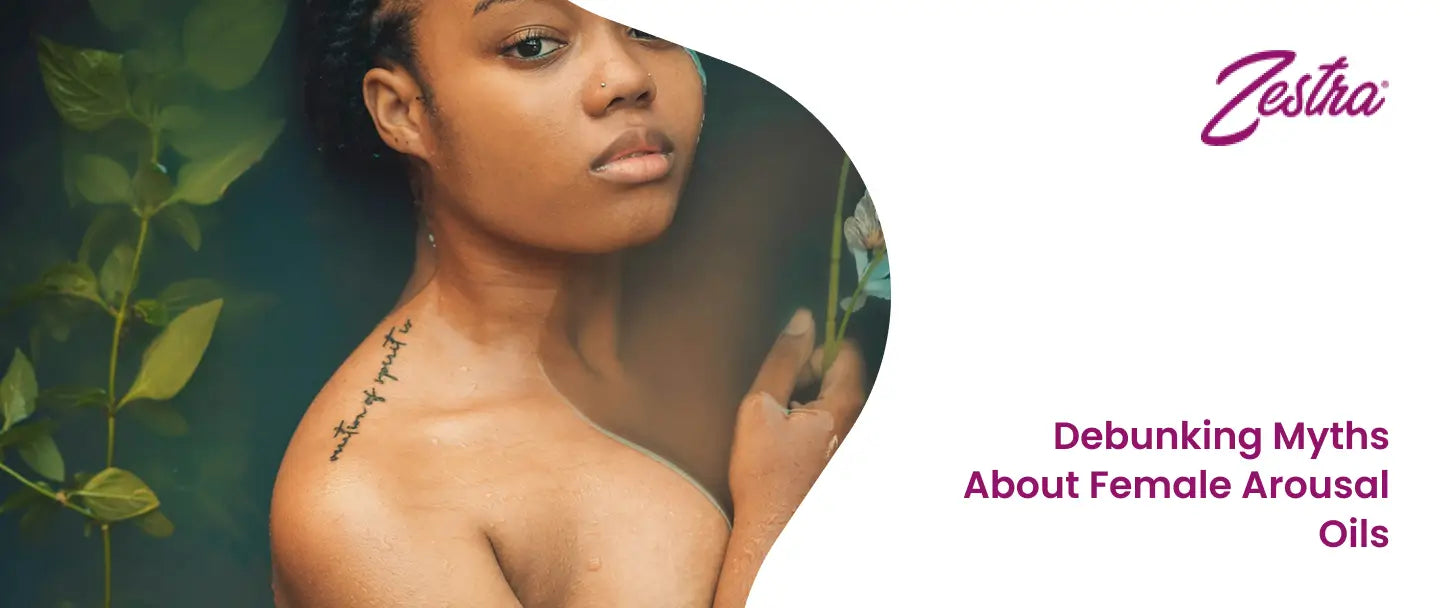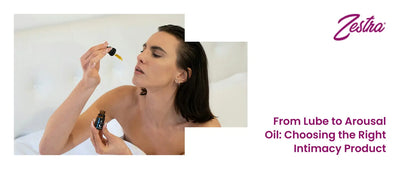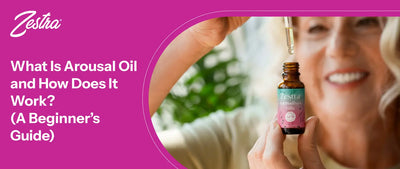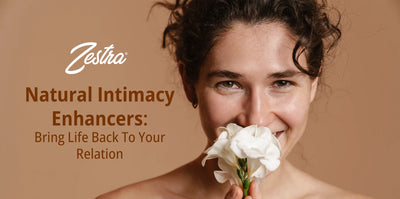Do Arousal Oils Really Work, or Are They Just Hype?
Have you ever looked at a product that promised “better intimacy” and wondered if it was too good to be true?
You’re not alone. Many women feel exactly that way when they hear about arousal oils. They ask the same questions: Are they safe? Do they actually work? Or are they just another trend built on clever marketing?
≈ 43 % of women report experiencing some form of sexual dysfunction (e.g. desire, arousal, orgasm, pain) in population-based studies.
For decades, women’s sexual health didn’t get the attention it deserved. Men had open conversations, prescriptions, and treatments designed specifically for their needs. Women, on the other hand, often faced silence, stigma, and very little research.
Even though intimacy is a vital part of well-being, it is rarely treated as such. When arousal oils entered the conversation, the curiosity was natural, but so was the doubt. Could a simple oil made from natural ingredients really enhance sensation, increase arousal, and make intimacy more enjoyable?
Why So Much Doubt Exists
Part of the hesitation comes from myths that have circulated for years. Some people assume arousal oils are “just lubricants,” when in reality, they work very differently. Lubricants reduce dryness and friction. Arousal oils, on the other hand, often contain ingredients like peppermint, cinnamon, or botanical extracts that increase blood flow and sensitivity, creating a warming or tingling effect.
Another myth is that all natural intimacy products are gimmicks. With so many untested items on the wellness market, skepticism is understandable. But not all products are the same, formulation, quality, and research matter.
What the Science Says
The good news is that modern research has started to close the knowledge gap. Clinical studies and peer-reviewed research now show that many plant-based compounds used in arousal oils can indeed enhance sensation and pleasure.
Among women with sexual dysfunction, 63 % report desire dysfunction, 77 % report arousal disorder, and 51 % report lubrication issues in an Indian sample.
Increased blood circulation, heightened nerve response, and relaxation effects are some of the documented benefits. Unlike pharmaceutical solutions that focus primarily on dysfunction, arousal oils aim to support everyday intimacy by making the body more responsive and comfortable.
The Role of Real Experiences
Beyond the lab, thousands of women have shared testimonials that echo these scientific findings. Many describe feeling more present, more relaxed, and more confident during intimacy.
Others highlight how these oils helped reduce anxiety and brought back the excitement they thought was gone. While results can vary from person to person, the overall trend shows that these products are more than hype, they can be genuinely helpful when chosen wisely.
Safety and Considerations
Of course, safety matters. Not all oils are created equal. Women should look for products that are dermatologist-tested, free of harsh chemicals, and specifically designed for intimate use.
45.3 % of women in a global sample had a “desire problem,” 37.5 % had arousal problems, 41.2 % had lubrication issues, and 42.0 % had orgasm problems.
Reading ingredient lists, checking for potential allergens, and choosing reputable brands can make all the difference. When used correctly, most arousal oils are safe and can be incorporated easily into intimacy routines.
Why So Many Myths Exist Around Female Arousal Oils
Sexual health is one of the most misunderstood areas of wellness, and when it comes to women, the misinformation is even deeper. Female arousal oils, designed to heighten sensation and support intimacy, are often surrounded by myths that create confusion and skepticism. Many women are curious about them but hesitate because of mixed messages. To understand why these myths persist, it helps to look at the history of sexual research, cultural attitudes toward women’s pleasure, and the way these products are often misunderstood.
Lack of Research in the Past
For decades, scientific research on sexuality was largely centered on men. While male sexual dysfunction received medical attention early on, women’s sexual function was left in the shadows. Female desire, arousal, and satisfaction were often treated as secondary or “too complex” to study.
In a systematic review, 41 % of reproductive-age women globally were found to be affected by female sexual dysfunction (FSD).
Until recent decades, very few clinical studies were conducted on female arousal or the effectiveness of products meant to support it. This lack of formal research left room for speculation, anecdotal claims, and marketing hype to dominate the conversation. Without clear scientific evidence, myths easily filled the gap.
Taboos Around Women’s Pleasure
Cultural silence has also played a huge role. In many societies, women’s pleasure was not considered important, or worse, it was stigmatized. Talking about arousal, lubrication, or orgasm was often considered improper.
Up to 40–50 % of all women report at least one symptom of sexual dysfunction (e.g. diminished desire, pain, arousal issues).
As a result, products that addressed female pleasure were marketed quietly or dismissed as indulgences rather than legitimate tools for well-being. This taboo meant women had fewer opportunities to share honest experiences or get accurate information from trusted sources. Instead, whispers, assumptions, and half-truths shaped public perception. When a subject is not openly discussed, myths tend to thrive.
Confusion With Lubricants
One of the most common misunderstandings is the idea that arousal oils are the same as lubricants. While lubricants reduce friction and dryness, arousal oils are designed with ingredients that increase sensitivity and blood flow to intimate areas. This creates a warming, tingling sensation that enhances pleasure.
In a meta-analysis, 64.6 % of sedentary (low-activity) women showed prevalence of sexual dysfunction, compared to 47 % in more active women.
But because both products are applied in similar ways, many people assume they serve the same function. This confusion often leads to dismissive attitudes, with some thinking arousal oils are unnecessary if lubricants already exist. In reality, the two are complementary, not interchangeable.
Skepticism of Natural Products
Another reason myths persist is the skepticism surrounding natural wellness products in general. The sexual wellness market, like many health industries, has seen its share of gimmicks and exaggerated claims. From “miracle” supplements to dubious devices, consumers have been trained to be cautious.
Around 40 % of women experience changes in sexual function around menopause (e.g. reduced responsiveness, pain, lower desire).
This healthy skepticism sometimes gets misapplied to high-quality, clinically tested arousal oils. Many assume they are just another fad or placebo, without realizing that modern formulations are often backed by science and real-world results.
The Role of Marketing and Misinformation
The way products are advertised also fuels confusion. Some brands exaggerate benefits, while others use vague, mysterious language to sell the idea of “exotic arousal.” Without consistent, transparent information, women are left wondering what is true and what is hype. Add to this the rapid spread of misinformation on social media, and it’s easy to see why myths remain strong even as science progresses.
Where We Are Now
Fortunately, the landscape has changed in recent years. Clinical trials, peer-reviewed research, and advances in women’s sexual health have brought credibility to this space.
High-quality arousal oils today are carefully formulated, often using botanicals and essential oils that have been studied for their effects on blood flow and sensitivity. Thousands of women have shared testimonials highlighting real, positive experiences, helping to replace myths with evidence.
In the U.S., in the general population, ~22 % of women report low sexual interest (based on older DSM-IV categories).
Science has finally caught up with what women have always known: pleasure is an important part of health and well-being. By breaking through the taboos, clarifying misunderstandings, and demanding higher standards for products, we are moving toward a more informed and empowered conversation. Female arousal oils are no longer just curiosities shrouded in myth, they are legitimate tools that can enhance intimacy, confidence, and connection.
Myth 1: Arousal Oils Are Just Fancy Lubricants
This is one of the most common arousal oil myths. While lubricants help reduce dryness, arousal oils go further.
In epidemiologic surveys, nearly 50 % of women complain either difficulty becoming aroused or general sexual dissatisfaction at some point.
- How They Work: Arousal oils increase blood flow, create gentle warmth, and heighten sensitivity in the genital area.
- Timing: They act within minutes, making them ideal for spontaneous intimacy.
- Studies: A double-blind, placebo-controlled trial published in the Journal of Sex & Marital Therapy found that women using Zestra® reported significant improvements in arousal, orgasm satisfaction, and genital sensation compared to placebo (PubMed).
So no, they aren’t “just lube.” They work on the body’s arousal process itself.
Myth 2: They’re Unsafe
Another major concern is whether arousal oils are harmful. Safety matters, especially when it comes to intimate health.
In the U.S., approximately 40 % of women have sexual concerns, while 12 % of women have frequent distressing sexual problems.
- Clinical Safety Data: In trials, arousal oils showed minimal side effects, mainly mild warmth or tingling, which is the intended effect.
- No Hormones or Prescriptions: Unlike hormone replacement therapy or drugs like Addyi, arousal oils are topical, natural, and non-hormonal.
- Long-Term Use: Studies show they can be used over months without negative effects.
Compare that to prescription medications, which often cause dizziness, nausea, or even risks with blood pressure (FDA). Oils are far gentler.
Myth 3: They Don’t Work for Older Women
Many believe orgasm or arousal is “over” after menopause. This is one of the most damaging arousal oil myths.
In European samples, ~27 % of women are estimated to suffer from sexual dysfunction, with desire issues being most common.
- Fact Check: Research shows up to 60% of postmenopausal women experience vaginal dryness that interferes with intimacy (NIH).
- Arousal Oils’ Role: They reduce dryness, increase sensitivity, and create comfort, making pleasure possible again.
- Testimonial Evidence: Many women in midlife or beyond report improved intimacy with consistent use.
Pleasure doesn’t expire. Oils make sure of that.
Myth 4: They’re Only for Women With Problems
Some assume arousal oils are only for those who “can’t” reach orgasm or have medical issues. That’s not true.
- Versatility: Women of all ages, single, partnered, post-baby, or post-menopause, can benefit.
- Enhancement, Not Just Fixing: Even women with healthy arousal cycles use oils to boost sensation.
- Research Note: Arousal oils have been studied in diverse groups of women, not just those with sexual dysfunction.
It’s like asking if only tired people can drink coffee. Oils can be enjoyed by anyone who wants more sensation.
Myth 5: They Work Like a Magic Pill
Some people expect arousal oils to cause instant, dramatic results without context. But that’s another arousal oil myth.
In clinical use, ~70 % of women in some trials reported increased desire, arousal, and satisfaction using Zestra.
- Reality: Oils improve sensitivity and comfort, but foreplay, connection, and mood still matter.
- Science: They work locally on nerve endings and blood flow, not on the brain’s chemistry.
- Clinical Evidence: In trials, results were strongest when women combined oils with foreplay and intimacy, not when applied without context.
Think of them as a partner to intimacy, not a replacement.
Myth 6: All Arousal Oils Are the Same
Not all products are created equal. This arousal oil myth can lead to disappointment.
- Ingredient Quality: Some oils on the market use synthetic or harsh ingredients.
- Evidence Matters: Zestra is one of the few arousal oils backed by clinical trials.
- Consumer Safety: Always look for products tested in peer-reviewed research, not just marketed with claims.
Among sexually active women ages 18–59, about one-third report lack of interest over the past 12 months; ~25 % with a partner report difficulty achieving orgasm.
Quality control separates trusted solutions from gimmicks.
Myth 7: They’re Embarrassing to Use
Many women hesitate to buy or discuss arousal oils because of stigma. But using tools for sexual wellness is no different from using skincare or vitamins.
In a Polish population sample, 40 % of women had at least one self-reported sexual dysfunction.
- Normalizing Intimacy Products: Studies show that more than 50% of women over 50 use sexual wellness aids, including vibrators and lubricants (Kinsey Institute).
- Privacy and Discretion: Oils are easy to use, come in small bottles, and don’t require medical visits.
- Empowerment: Many women report feeling more confident, not embarrassed, after taking control of their pleasure.
Breaking stigma is part of reclaiming joy.
Why Natural Oils Often Outperform Pills
Prescription drugs for women, like Addyi or Vyleesi, often sound promising but have mixed results.
In a NIH-registered Phase-3 type trial, ~256 women were randomized to Zestra or placebo; 178 completed the study; no serious adverse events observed.
- Addyi Data: Women had only 0.5 to 1 additional “satisfying sexual event” per month compared to placebo (FDA Trials).
- Vyleesi Data: About 25% reported increased desire, but nausea and headaches were common (NIH Review).
In contrast, arousal oils:
- Act within minutes.
- Have fewer side effects.
- Work for a broad age range.
- Support comfort as well as desire.
They don’t fight the body. They work with it.
FAQ: Debunking Arousal Oil Myths
1. Are arousal oils safe for daily use?
Yes. Clinical studies show minimal side effects and good safety profiles even with long-term use.
2. Do they replace lubricants?
No. They’re different. Lubricants reduce friction, while oils boost sensitivity and arousal. Many women use both together.
3. How fast do they work?
Most women feel effects within 5–10 minutes.
4. Can they help during menopause?
Yes. Oils ease dryness and enhance sensation, which are two major barriers after menopause.
5. Do men notice a difference?
Yes. Many partners report intimacy feels warmer, smoother, and more enjoyable when oils are used.
6. Are results guaranteed?
No product works for every single person, but oils backed by clinical data, like Zestra, show consistent benefits for many women.
7. Is it embarrassing to use them?
Not at all. They’re private, discreet, and no different from other self-care items.
Why Zestra Is the Best
After reviewing the science and clearing the confusion, one name stands out: Zestra®.
One clinical trial of Zestra (a botanical arousal oil) showed significant improvements in desire, arousal, and treatment satisfaction vs placebo.
- Clinically Proven: Supported by peer-reviewed research, unlike many competitors.
- Fast-Acting: Works in minutes, perfect for spontaneous intimacy.
- Non-Hormonal: Safe for women who can’t or don’t want to use hormone therapy.
- Trusted by Women Worldwide: Testimonials highlight renewed confidence, intimacy, and joy.
If myths kept you away before, it’s time to know the truth: arousal oils can change the way women experience pleasure. And Zestra leads the way, with safety, trust, and proven results.





